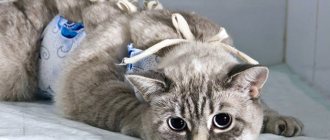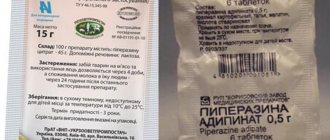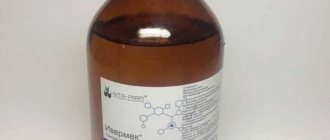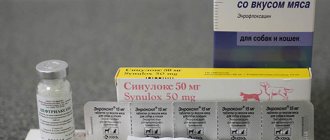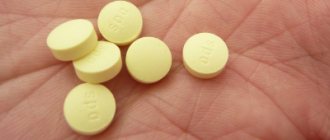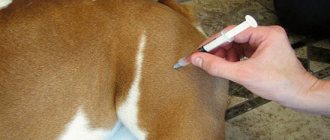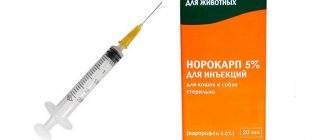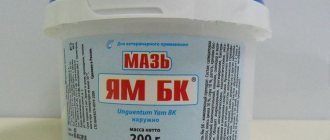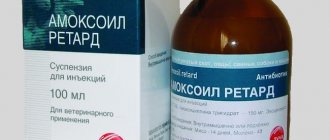It is undesirable to use medical “human” drugs in veterinary medicine. Veterinary pharmacies offer many more effective and safer specialized products for animals. However, sometimes a situation may arise when taking a human remedy is necessary for some reason. The instructions for its use characterize piperazine as a relatively safe agent with a narrow spectrum of action that can be used for deworming animals.
Composition and analogues
Piperazine is a synthetic drug that has anthelmintic properties. It is available in tablets, the main active ingredient of which is piperazine adipate, that is, it is a one-component medicine. Talc, sodium starch, etc. are used as excipients. The concentration of the active substance in one tablet is 500 mg.
Sold only under its own name. It has no analogues on the market at the moment.
Depending on the manufacturer, the cost of the drug varies from 10 to 20 rubles. In Russia, the product is sold from the manufacturers Sintez AKOMP, Darnitsa. It goes on sale in paper blisters of 6 and 10 tablets. The tablets are round, flat, odorless, without a shell. The color is light - from white to yellowish.
The drug effectively treats ascariasis in children, adults and animals. However, it is ineffective against other invasions. A distinctive feature of this drug is its very low toxicity compared to other anthelmintic drugs. It is even allowed for pregnant women and, in some cases, people with liver and kidney diseases (as prescribed by a doctor).
Limitations and side effects
Although the medicine is considered harmless, there are restrictions on taking Piperazine.
In what cases should cats not be given the drug:
- kittens under 14 days of age;
- in case of intolerance to the components of the drug;
- with increased sensitivity to the medicinal component;
- with a predisposition to allergies;
- for liver and kidney diseases;
- for disorders of the nervous system;
- with poor functioning of the digestive system.
Pregnant and lactating cats can use Piperazine only as prescribed by a doctor. The anthelmintic should not be used in combination with other anthelmintic drugs containing pyrantel.
Side effects may occur when taking the drug:
- nausea, vomiting;
- loose stools;
- impaired coordination of movements;
- tremor - involuntary twitching and trembling of the paws.
In case of individual intolerance, allergic manifestations are possible - rash and redness of the skin. In rare cases, anaphylactic shock, in which case immediate contact with a veterinarian is required.
Operating principle
After entering the body, after 1.5-2 hours the active substance of the drug penetrates the intestines. There it has a toxic effect on the worms, disrupting their neuromuscular regulation and the transmission of impulses from the muscles to the nervous system. The result is paralysis. Parasites detach from the intestinal walls and are eliminated from the animal’s body.
Since the worms do not die, the body is not poisoned by toxic decay products. Most of the worms come out with the first stool, and almost immediately after ingestion, the symptoms of infestation bother the cat or dog much less. The active substance itself is quickly absorbed into the blood in the gastrointestinal tract and excreted on the first day, mainly by the kidneys (to a lesser extent by the liver).
Piperazine: what is it for, how does it work
The medicine contains the active component piperazine adipate . It is toxic to worms and a few hours after ingestion, intestinal parasites experience a disruption in the transmission of nerve impulses, which leads to disruption of muscle regulation, and then to paralysis and inability to attach to the intestinal . Nematodes leave the animal's body in feces during defecation.
The fact that the worms do not die, but are removed alive, prevents the development of intoxication body . This allows the drug to be used to treat lactating and pregnant females, small puppies or kittens over 2 weeks old.
Piperazine only affects roundworms.
The instructions indicate that the product is used to treat the following helminthic infestations:
- ascariasis;
- amidostamosis;
- toxocaridosis;
- neoascariasis.
The effectiveness of the drug is high. 90-95% of the active substance is absorbed in the digestive tract, so worms quickly lose their ability to stay in the intestines. dose of powder or tablet is sufficient to cure . In case of severe infection , the medicine is prescribed in a short course up to 3 times with an interval of 1-3 weeks, depending on the condition of the animal.
Due to its limited spectrum of action, piperazine is rarely used for prophylaxis . Anthelmintic therapy is carried out 10 days before mating or before vaccination, to prevent possible infections if the pet roams freely on the street.
Be sure to read:
TOP 5 drugs for the treatment of ear mites in cats: prices and reviews
Scope of application
The spectrum of action of the product is narrow. It is prescribed when the following diagnoses are made:
- Infection with roundworms (especially chicken ascariasis);
- Passalurosis in rabbits;
- Amidostomiasis in waterfowl (especially geese);
- Toxocariasis in cats and dogs;
- Neoascariasis in cattle;
- Parascariasis in horses;
- Ascariasis of pigs.
Theoretically, chickens can also take it for preventive purposes, since this is the type of infestation that occurs most often in them. However, due to the narrow spectrum of action of the drug, there is a high probability of becoming infected with something else.
Usage
Piperazine can also be given to animals and can also be used for birds. It is actively used in veterinary medicine, but the dosage must be calculated very carefully, since even though the drug is relatively safe, it can cause intoxication in case of overdose.
- For dogs, the dosage is 0.5 g per 1 kg of animal weight. For puppies up to three months, it is better to calculate it individually under the supervision of a veterinarian. The dog is given a single dose, after which the course can be repeated after 21 days if the infection is severe;
- For cats, the dosage is calculated in the same way as for dogs. The dosage for kittens under six months of age should be calculated by a doctor. Cats also need a one-time dose, but repeat it after 21 days;
- For chickens, waterfowl and parrots, treatment is carried out for two consecutive days or for three days, but when taken every other day. In chickens, the medicine is given in a group method during morning feeding. The dosage for chickens is calculated as 2.5 g per 1 kg of weight, for ducks - 0.5 g per 1 kg of weight, for geese - 1 g per 1 kg of weight, for parrots - individually depending on the species;
- Piglets and small cattle are given 0.7 g of the drug per 1 kg of body weight (but not more than 15 g at a time) for two days in a row, for two days. Although, when calculated by weight for pigs, such a dosage may be insufficient. The course can be repeated if necessary after 2 months;
- For cattle, the dose is calculated as 0.7 g per 1 kg of animal weight. But no more than 160 g at a time. Treatment is carried out once.
Instructions
The dose is selected individually, depending on the weight of the animal, health status, infection, and individual characteristics of the body. The medicine is given 1 time or for 2 days. Add to water and mix with food.
- Piperazine for cats. The dose is calculated very simply - 0.5 g per 1 kg of animal weight. You just need to know your pet's body weight. Cats should be given the medicine once in the morning along with their food. Or dissolve the required amount of the drug in water, fill a syringe without a needle, and pour it into the mouth. Piperazine for worms will be forced into the cat. Since the medicine has an unpleasant taste, the animal does not want to eat it. Piperazine for cats and dogs
- Instructions for using Piperazine for dogs are similar. The dose is calculated at 0.5 g of active substance per kilogram of body weight. The dog only needs to be given the medicine once. Another scheme involves treatment for 2-3 days. The medicine is given daily or a break of 2 days is observed. This treatment regimen is used when the pet is severely infected. The dosage of Piperazine tablets for dogs is calculated similarly - based on the animal’s body weight. 1 tablet contains 0.5 g of active substance.
- Piperazine for pigeons. The dose calculation is identical to 0.5 g per 1 kg of weight. The product is dissolved in water, poured into sippy cups, and other liquid is removed. Do not add a new portion until the medicine is drunk. Another option is to drop it into the beak with a pipette. An anthelmintic drug for chickens is used in the same way.
- Piperazine for pigs. The regimen and dose are somewhat different from the treatment of cats and dogs. The required amount for piglets is calculated as 3 g per 1 kg of weight. Treatment is carried out 2 days in a row in the morning. Mix with water. Repeat the course if necessary after 20 days.
Piperazine is given for worms in cattle, goats, sheep, horses, and rabbits. Treatment is carried out for 1 day or 2. Rabbits are not fed for 24 hours before starting therapy.
It is strictly forbidden to give the drug if there is an individual intolerance to the components of the drug. It manifests itself as an allergic rash on the skin, deterioration in health. Piperazine tablets should not be given to a pregnant cat, dog, or other animal that is pregnant. Treatment cannot be carried out during lactation.
Do not give the antiparasitic drug to weakened, sick animals, or if there are problems with the liver or kidneys.
Piperazine is a low-toxic drug, but can cause side effects. During the first 2 days:
- tremor of the limbs;
- change in gait;
- weakness;
- increased salivation;
- vomit;
- diarrhea.
The condition returns to normal in a few days. Treatment is symptomatic. After completing the course of therapy, pets are given vitamins, probiotics, and natural immunostimulants to strengthen their defenses and normalize their intestinal microflora.
Severe side effects requiring emergency assistance include:
- vomiting;
- difficulty breathing;
- paralysis;
- arrhythmia;
- increased body temperature;
- convulsions;
- foaming at the mouth.
A reaction can occur in the presence of individual intolerance, overdose, or ignoring contraindications. If the animal is not provided with qualified assistance, it may die.
Contraindications and side effects
Piperazine adipate does not have as many contraindications and side effects as most anthelmintic drugs. This is its significant advantage. You can deworm an animal with it without fear for your pet’s health. However, in some cases the drug is not used.
- With great caution, you can give medicine to a cat or dog with reduced gastrointestinal motility;
- It is undesirable to use in cases where the animal has impaired functioning of the kidneys and liver (this includes failure and other serious diseases);
- Hypersensitivity or allergic reaction (or other type of intolerance) to the main or auxiliary substance, including a history;
- Piperazine can be given to kittens or puppies, as well as pregnant and lactating females, but strictly under the supervision of a veterinarian.
Despite the fact that the drug is quite safe, it can nevertheless cause some side effects: vomiting, softening of the stool or diarrhea, changes in gait. In case of overdose, allergic reactions may also occur. One of the most serious consequences of an overdose is paralysis. Therefore, if you suspect an overdose and if the severity of side effects increases, you must immediately go to a veterinary clinic.
When treatment with Piperazine is carried out, other anthelmintic drugs, especially Pyrantel, should not be used, as this can cause intoxication.
PIPERAZINE ADIPINATE. Piperazinum adipinatum.
Synonyms: adipilite, adipazine, entacyl, entazine, gelmirazine, vermitox, nema-tocton, nomethane, oxyrazine, piperaskate, heltalan, helmirazine, etc.
Properties. White crystalline powder, odorless, with a slight pleasant taste. Soluble in cold water, very soluble in hot water, practically insoluble in 95% alcohol, ether, and chloroform.
Release form. Produced: powder and tablets of 0.2-0.5 g.
Store in well-sealed bottles, in a dry place, protected from light.
Action and application. Piperazine adipate is an effective anthelmintic against ascariasis, nematodes, oxyurosis, toxocariasis, toxascariasis; affects ganglion cells, enhances the movement of parasites and causes their paralysis.
In therapeutic doses it is relatively non-toxic for animals. Large doses (orally) can cause vomiting, increased peristalsis, diarrhea, and impaired coordination of movements.
Piperazine adipate is used for parascariasis and trichonematiasis in horses, neoscariasis in calves, ascariasis in pigs, ascariasis and heterokidosis in chickens, amidostosis in geese, echinuriosis in birds, toxocariasis, toxascariasis, uncinariasis and hookworm in dogs and fur-bearing animals.
Rabbits with passalurosis are prescribed after an 18-24-hour fasting diet individually or in a group with food (wet mash or crushed root vegetables) for therapeutic purposes: in a dose of 1 g/kg of animal weight once or 2 days in a row in a single dose of 0.5 g/ kg of weight for adult rabbits, and for young animals after weaning for 2 days in a row in a single dose of 0.75 g/kg; For prophylactic purposes, it is used in young animals after weaning by feeding feed with the drug in a daily dose of 0.1-0.15 g/kg of animal weight.
Geslings with amidostomiasis are prescribed in a group method in a mixture with food 1:10 for three days in a row in a single dose of 1 g/kg of bird weight without dietary restrictions.
To prevent metastrongylosis in pigs, 0.05 g/kg of animal weight with feed is recommended. Group fed daily during the grazing season.
Oral doses: horses 12-15 g; dogs 1.5-2 g; chickens 0.5-1 g.
Piperazine is a broad-spectrum anthelmintic drug. The drug is available in the form of tablets - for use in adults, and also in the form of a solution - for more convenient use for helminthiasis in children.
Piperazine against worms indications for use
Piperazine is not a drug that is used for all helminthic diseases; it is prescribed only for enterobiasis and ascariasis.
Therefore, if the patient needs to be treated for helminthiasis, he is prescribed another drug. However, if only worm eggs are found in a child or adult, then this drug is taken, so you can avoid poisoning the body with stronger tablets when there is no urgent need to take them. Piperazine against worms is used in cases where:
- Eggs of worms, in particular roundworms and pinworms, have been found in human feces.
- A person feels constant itching in the anus.
- Abdominal pain occurs, appetite decreases, and nausea appears. All this can manifest itself as a result of the vital activity of parasites that release their poison into the intestines.
- Red spots appear on the skin that do not go away when using any ointment or cream, when their nature is unclear at first glance.
This medicine is also used to remove worms from animals.
Contraindications
Despite the fact that the drug is practically non-toxic, if the correct dosage is observed, it is not prescribed to all patients. Unlike other anthelmintics, Piperazine has few contraindications for worms, and can even be prescribed to pregnant women and children, but in this case it is necessary to consult a doctor.
It is not recommended to take the medicine for children under three years of age (this applies to taking tablets; injections are allowed only under the supervision of a doctor and only in certain cases).
If patients have a high sensitivity to the components of the drug or intolerance, they should not take it either, otherwise unwanted allergic reactions may occur.
If a person has an organic lesion of the central nervous system, the medicine should not be taken.
For people with renal failure, taking Piperazine is contraindicated, since the drug is largely excreted in the urine; in some cases, it can only be taken under the supervision of a doctor.
Side effects
Piperazine in tablet form can be prescribed to both adults and children, since the drug is easily tolerated and practically does not cause adverse reactions. Side effects may occur if Chlorpromazine is also taken during treatment. If a person experiences side effects from this medicine, they may be mild in the form of mild nausea, minor headache, drowsiness, and the patient may have a stomach ache when taking them.
Rarely, if a person has kidney problems, the drug can cause poisoning. If the patient suffers from severe renal failure, tremors of the limbs, hallucinations may begin, vision may temporarily deteriorate, coordination of movements may be impaired, and muscle weakness may also occur, which is expressed in a person’s state when he wants to lie down or the person gets tired for no reason.
If adverse reactions in a person are mild, then the drug is not discontinued and the patient undergoes the full course of treatment. If a person experiences severe adverse reactions, they should stop taking the medication and treat the symptoms. In this case, the doctor should select a similar drug.
Adverse reactions in case of overdose may include tremors of the limbs, muscle weakness, severe nausea, abdominal and head pain, vomiting, diarrhea or constipation. Such symptoms must be treated by removing toxins from the body. The patient needs to take sorbents; sometimes the patient is prescribed laxatives, since this drug can cause constipation. If severe poisoning with the drug occurs, it is necessary to put in a drip or administer Thiamine.
Release form and composition
Piperazine is available in the form:
- Tablets.
- Solution for internal use.
Piperazine tablets are available in paper sheets of 6 or 10 pieces. Piperazine solution for internal use is available in a volume of 100 ml.
Piperazine tablets are white tablets without shades or inclusions. The main active ingredient is piperazine adipate in a dosage of 0.5 g of the substance in one tablet. The solution contains 50 mg of piperazine adipate per 100 ml.
Patients who want to get rid of helminths often ask for natural remedies with the least side effects. In such cases, I recommend this remedy.
Instructions for use of Piperazine
Piperazine has different release forms for children and adults, and also has features of administration for certain helminthiases. All options for using the drug can be found in the instructions for use.
Piperazine for adults
Piperazine is prescribed by a doctor; there is also the possibility of self-prescription, especially if the nature of helminthiasis is known.
The drug in tablet form is prescribed to children over 10 years of age and adults according to the following scheme:
- For ascariasis. The daily dose should not be more than 4 g. Treatment for ascariasis lasts 2 days, on the first day 4 g are prescribed in 2 doses. The drug should be used several hours before meals, or a couple of hours after. On the second day, 3 g of the substance in the same way, in 2 doses.
- With enterobiasis. Treatment of enterobiasis with Piperazine will be quite long, due to the nature of the onset and development of the disease. In the first 3 days, the drug is taken in a dosage of 4 g, divided into 2 times, also before or after meals several hours; in the next 2 days, use 3 g of the substance in 2 doses. After taking the pills for five days, wait 5 days and repeat the course. According to this system, in case of enterobiasis, it is necessary to take 3 courses, that is, 15 days, taking a break every 5 days. Thus, treatment of enterobiasis lasts 30 days.
- For mixed helminthiases. For mixed helminthiases, Piperazine is taken according to the same regimen as for ascariasis, increasing the treatment period to 5 days.
Piperazine for children
How to take piperazine for a child can also be found in the instructions for use. For convenient children's use, a liquid form of the drug has been developed, which makes taking the medicine much easier, especially for the youngest.
Piperazine in the form of a solution for children is used orally according to the following scheme:
- For ascariasis:
- up to 12 months: The daily permissible dose of the substance for a child is up to 0.4 g. The dose is divided into 2 times, in each of which it is necessary to take 0.2 g.
- from 12 months to 3 years: The daily dosage of the drug for children under 3 years of age is 0.6 g. 0.3 g 2 times a day a few hours before or after meals.
- from 4 to 6 years: The permissible daily dose is 1 g of the substance, taken according to a similar schedule.
- from 6 to 8 years: The dosage is 1.5 g per day. Can be used in one dose after meals.
- from 8 to 10 years the daily dosage increases to 2 g.
Piperazine for prophylaxis
The drug can be used for prophylactic purposes. Especially with all kinds of risk factors for infection, the drug is prescribed immediately. Such risks include contact with animals or people with helminthiasis.
For prophylaxis Piperazine is taken:
- Children - 0.2 g per day, for 2-3 days.
- Adults – 1 tablet per day, for 4-5 days.
Reviews of Piperazine for animals
The drug effectively destroys sexually mature and immature individuals, and does not affect migrating larvae. After 20 days, you need to do the tests again. If parasites are detected, the therapy is repeated. To prevent infection, the medicine is given once.
I gave anti-worm medication to dogs and puppies. Nothing bad happened to the animals as a result of the medication, but they suffered for a day. They ate nothing, slept, had diarrhea, one puppy vomited. A day later the condition returned to normal. The worms were cured in one go.
Anna, Voronezh
Human medications are often given to cats for deworming. I chose Piperazine. It is cheap, can be found in any pharmacy, and does not cause side effects. For a day, drool rolls out of his mouth, tears run, he refuses to eat, then everything is fine. We've been using it for two years now.
Alina, Moscow
The drug is sold in pharmacies and is available without a prescription. A package of 10 tablets costs around 20 rubles. The cost of a 15 g bag of powder is similar. Should be stored away from sunlight. The shelf life is 3 years from the date of manufacture.
Can't deal with parasites?
Helminths are dangerous to the body; their waste products are toxic and provoke inflammatory processes where they live.
Treatment should be started immediately! Protect yourself and your loved ones!
In such cases, our readers recommend using the latest remedy - Tibetan collection TIBETTEA against parasites.
It has the following properties:
- Kills more than 120 types of parasites in 1 course
- Has an anti-inflammatory effect
- Breaks down and removes eggs and larvae of parasites
- Destroys pathogenic bacteria and viruses
- Removes waste and toxins
Side effects and contraindications
Side effects of the drug are observed quite rarely, usually when the permissible dose is exceeded. Piperazine differs from other drugs in its safest use and very rare undesirable consequences of taking it.
The following possible side effects can be noted:
- Headache;
- Dermatitis;
- Abdominal pain;
- Dizziness;
- Nausea;
- Digestive disorder.
Like any other medication, Piperazine has a number of contraindications. You should familiarize yourself with this list in detail before using the drug; if there are any serious restrictions, you should consult a doctor.
Contraindications to the use of Piperazine:
- Kidney failure;
- Liver failure;
- Intolerance to components by the body.
Stories from our readers!
“I’m buying a product for my parents. They live in a village and the risk of parasite infection is high. Taken for prevention. I don’t want to take medications with many side effects, so we chose this elixir.
The product is based on bee propolis, which has a pronounced antibacterial and antiviral effect. I like the drug because it is completely natural, based on herbs, and this is very important for prevention.”
Instructions for the use of Piperazine for the treatment of helminthiases in dogs
The substance is also effective for the treatment of helminthiasis in dogs. There is a powder form of the drug designed specifically for easy use in animals. Piperazine is the safe, most suitable and affordable treatment for the treatment and prevention of worms in dogs.
Mechanism of action
The drug affects the muscle activity of parasites, paralyzing them and depriving the worms of the vital skills of movement and feeding. After paralysis of the parasites, the death of adults occurs. Thus, the drug causes the death of adults, but is ineffective against larvae.
To treat helminthiasis in dogs using the drug Piperazine, it is necessary to take into account the mechanism of action of the drug and use additional measures to combat parasites. The drug is quickly eliminated from the dog’s body and does not cause any harm to health.
Indications for use
The drug is used to treat helminthiasis in dogs, as well as in other animals, including livestock.
To treat a dog, it is necessary to prescribe the drug in the following cases:
- Toxocariasis.
- Toxascariasis.
- Trichocephalosis.
- Hookworm.
These diseases are almost impossible to diagnose in a pet without the help of a veterinarian, as well as without tests.
But there are some symptoms that will indicate a possible dog infection with parasites:
- Nausea and vomiting, especially periodic and repeated;
- Digestive problems;
- Changes in the animal’s habitual behavior: infection with worms is usually marked by lethargy, apathy, the dog constantly lies down and does not show active behavior;
- Insomnia.
If several of these symptoms are observed, you should definitely show your pet to a doctor as soon as possible.
Dosage and treatment regimen
Treatment of helminthiasis in dogs with Piperazine occurs according to a certain scheme:
- The amount of powder preparation is applied once.
- For every kilogram of animal weight, 0.5 g of powder is taken.
- The powder can be added to your dog's food or drink.
For prophylaxis, the drug is used once at a dosage of 0.2 g per kilogram of weight. Prevention is carried out in the autumn-spring, and sometimes it is also possible in the summer.
Side effects of the drug Piperazine in dogs
It is very important to correctly calculate the dosage for the animal so as not to harm the body.
If the required amount is exceeded, as well as if animals are intolerant of the drug, the following side effects may occur:
- Digestive disorders in dogs (diarrhea or constipation);
- Nausea, gagging, vomiting;
- Loss of coordination;
- Allergic reactions in the form of redness of the inner surfaces of the ears, etc.;
- Problems with the dog's musculoskeletal system.
Contraindications for use
Contraindications for use in dogs are similar to those for humans:
- Problems and disorders in the liver and kidneys;
- Individual intolerance.
In case of any serious diseases of the animal’s digestive or nervous system, treatment with the drug should not be used without the advice of a doctor, as the drug may aggravate the course of the disease.
special instructions
The drug should not be given to a dog if it has been treated with an anthelmintic in the near future, and it is also necessary to adhere to certain restrictions:
- You should not give your dog milk or dairy products for food in the next week after treatment.
- Meat and meat products must be fully cooked, preferably boiled food.
- It is prohibited to carry out drug treatment or disease prevention on the same day of taking Piperazine.
Special instructions provide recommendations for the most complete therapeutic effect in conjunction with the activity of the drug.
Piperazine effectiveness, composition and recommendations for use
Have you been fighting against PARASITES for many years without success?
Head of the Institute: “You will be amazed at how easy it is to get rid of parasites just by taking it every day...
Piperazine is a time-tested anthelmintic that paralyzes nematodes by disrupting the functions of their neuromuscular system. The organic substance piperazine belongs to cyclic aliphatic amines and has a wide range of applications. In medicine, only salts of this substance are used, which have a pronounced anthelmintic property. The price of this drug is low, despite its gentle effect on the human body.
- Release form and pharmacological action
- Instructions for use
- Overdose symptoms
- Reviews about the drug
Release form and pharmacological action
The active substance of the drug "Piperazine" is piperazine adipate, which paralyzes helminths. Its effectiveness against parasites is 95%. To achieve a 100% result, repeated therapy is necessary.
The drug "Piperazine" is available in tablet form and in solution, which is usually used in pediatrics. Piperazine instructions for use, which includes all the necessary information on the dosage of the drug, should be used only as prescribed by a doctor. An anthelmintic drug is prescribed after confirming the diagnosis of helminthic infestations.
Indications for use of Piperazine:
- ascariasis (damage to the body by roundworms);
- enterobiasis (pinworm infection).
Reviews of the anthelmintic drug indicate that there are virtually no side effects when using it
It should be noted that the medicine has some contraindications, in the presence of which it should not be used to eliminate helminthic infestations. Among them are renal failure, central nervous system damage and hypersensitivity to the components that make up the
Instructions for use
Before starting treatment for helminthic lesions, it should be borne in mind that adipate (the active substance) does not remove parasitic worms from the body, but only has a paralytic effect on them. That is why, after carrying out the course of treatment recommended by the doctor, paralyzed helminths should be removed from the intestines using an enema. This will prevent the human body from being poisoned by decay products.
When treating ascariasis for adults, the following dosage regimen for Piperazine tablets is recommended: up to 3-4 g per day. The dosage is prescribed individually in accordance with the stage of damage to the body.
The drug in the form of a solution can be taken for the treatment of small children and pregnant women, since adipate does not have a negative effect on the body of newborns and on the fetus in utero. Regardless of this, the price of the drug is quite low compared to other anthelmintic drugs.
Treatment of children is carried out according to the following scheme:
The duration of treatment is determined by the type of parasitic worms that caused the disease:
- for ascariasis - taken for 2 days, the dosage is divided into 2 doses per day;
- for enterobiasis - therapy lasts up to 5 days.
To completely expel pinworms from the body, it is recommended to carry out 1-3 courses of treatment with Piperazine in a row. There is a break of at least 7 days between them
Adipate can cause an overdose, so caution should be used when calculating the dosage of the drug during pregnancy and for children
Overdose symptoms
Self-medication with Piperazine can cause an overdose, which is accompanied by nausea, headache and abdominal pain. Characteristic weakness and tremor may develop, which is especially common in people with renal failure and during pregnancy.
To eliminate an overdose, gastric lavage is mandatory and a saline laxative and absorbents are prescribed. In severe forms of overdose, there is a need for blood transfusions and oxygen therapy. That is why during pregnancy the dosage of the medicine should be prescribed by a doctor, taking into account the characteristics of the woman’s body and the presence of concomitant diseases.
Piperazine or Pyrantel – which is better?
When choosing an anthelmintic drug, you want high efficiency to be combined with safety of use. Today there are many anthelmintic drugs on the market, and, in addition to the affordable and popular Piperazine, there is the no less popular Pirantel. Instructions for use of the drug Pirantel can be read here.
To find out which drug is better and more suitable for the treatment of helminthiasis, it is necessary to understand the mechanism of action of these two drugs.
Features of Piperazine:
- Piperazine is active against enterobiasis, ascariasis or mixed helminthiasis, that is, in the presence of these two parasites at the same time.
- Low cost.
- Possibility of using the drug for children and animals.
- Safety of use.
- Release form: powder, tablets, solution.
Pirantel has its own characteristics:
- Wider spectrum of action.
- Release form: tablets.
- Cannot be used for children under 3 years of age.
- Low cost.
- Take with meals.
- More frequent side effects.
The drug Piperazine is a very popular anthelmintic drug, available not only for adults, but also for small children and animals. Low cost and high effectiveness against certain types of parasites make this drug one of the most popular on the pharmaceutical market.
